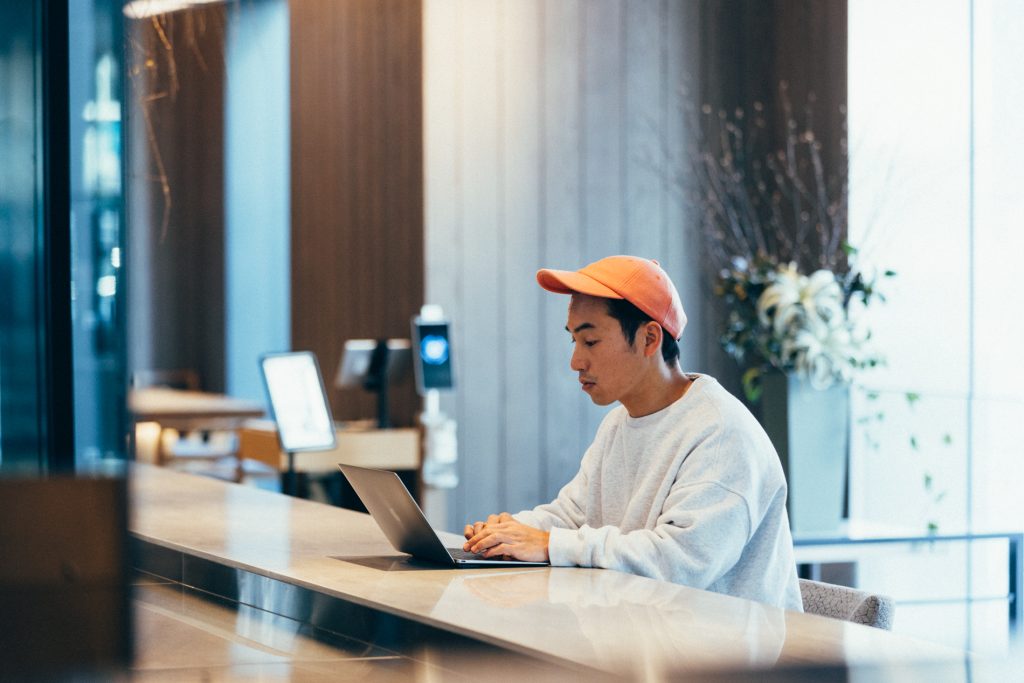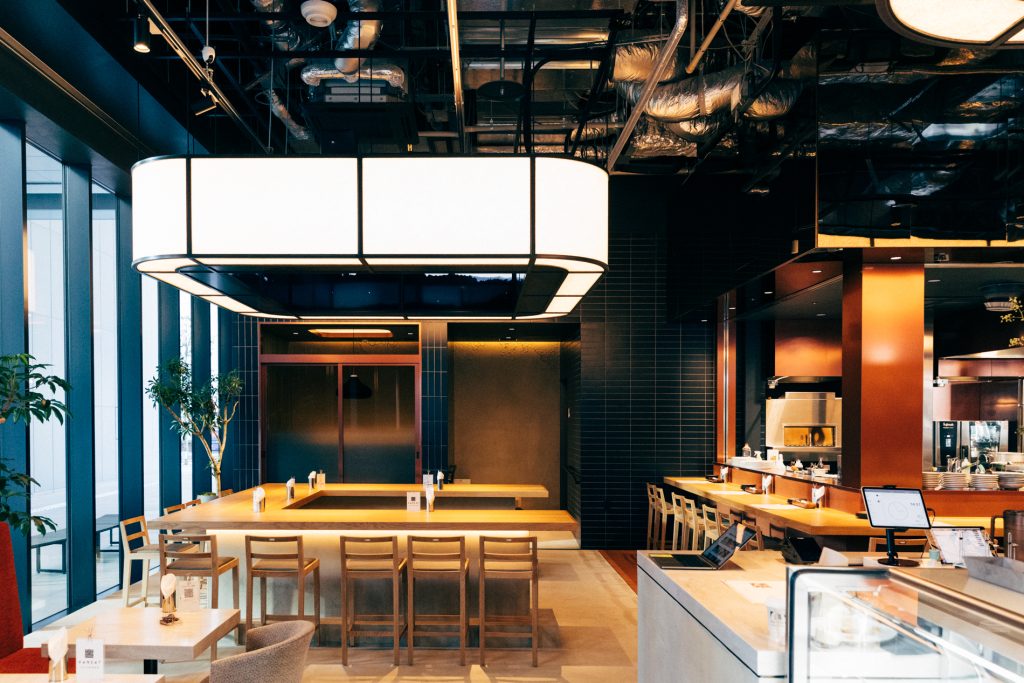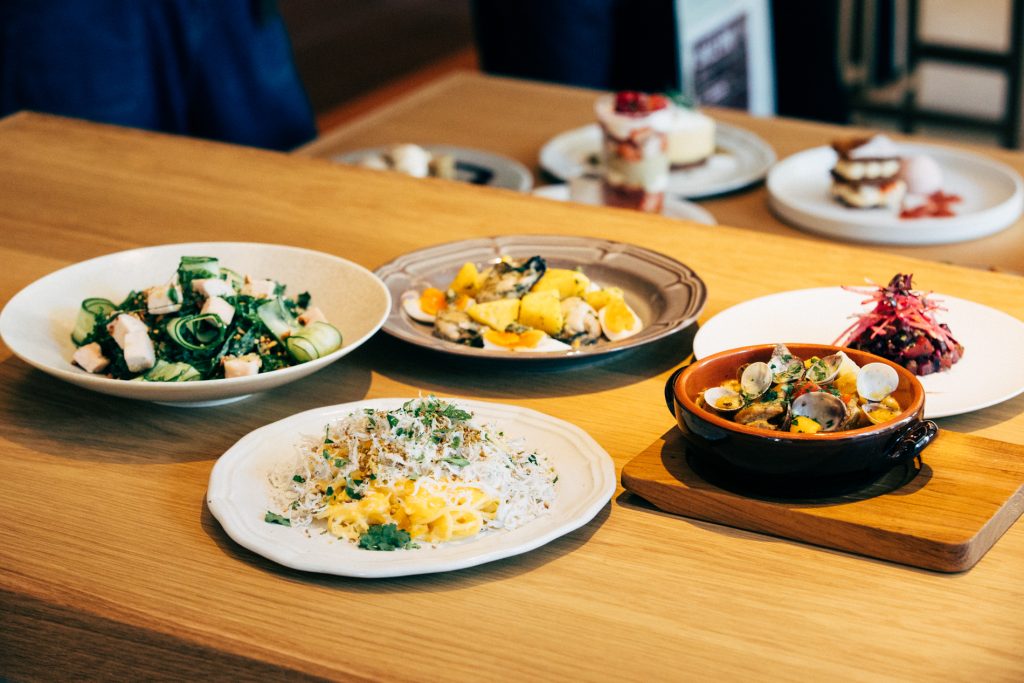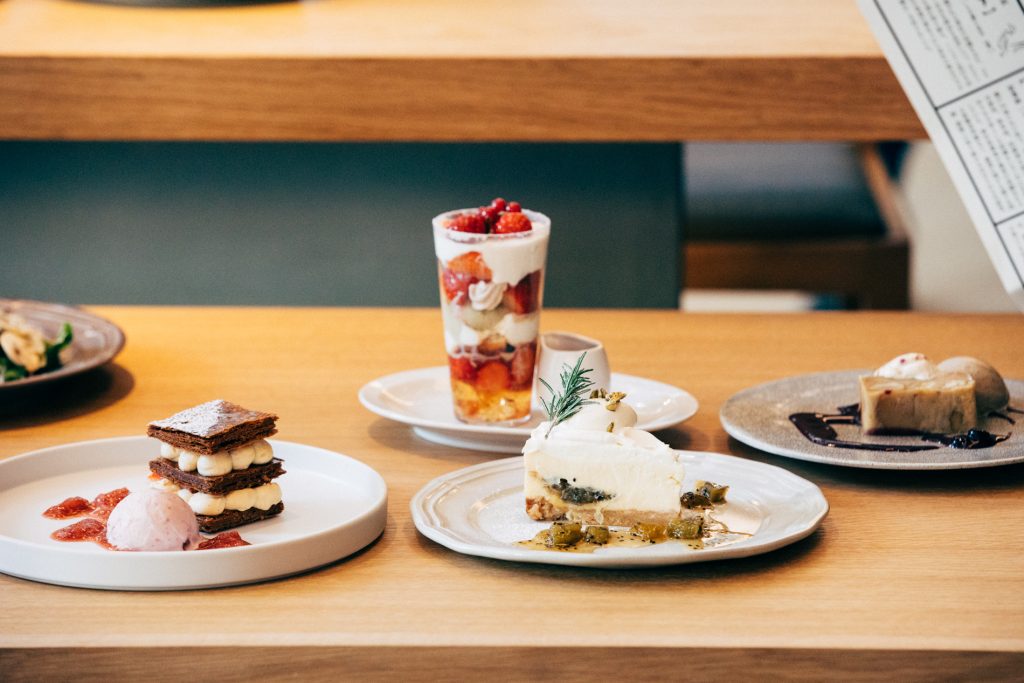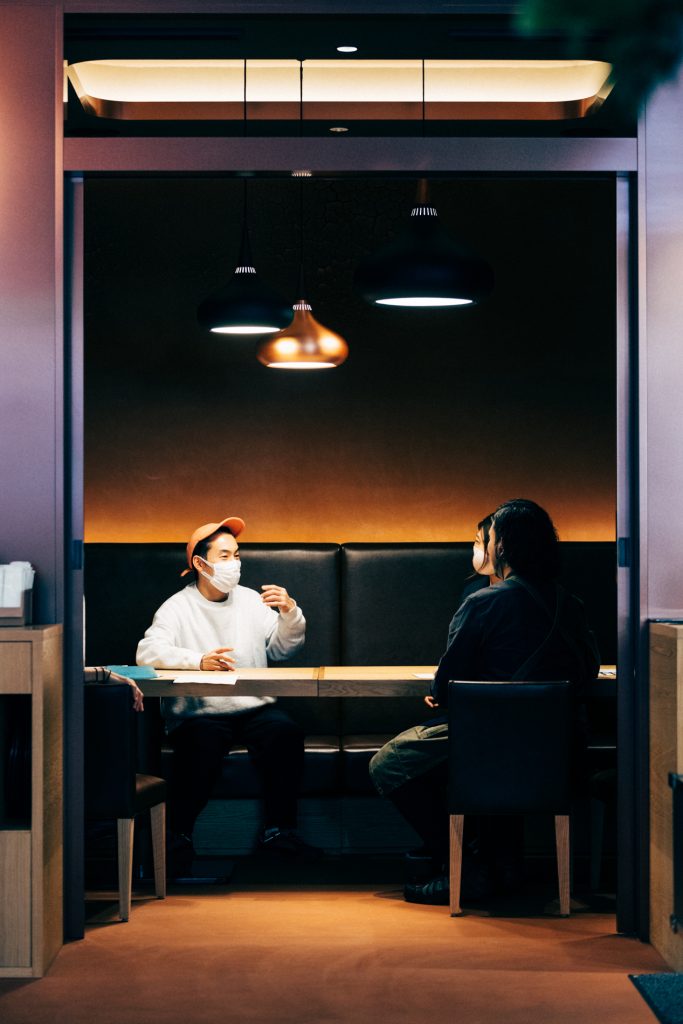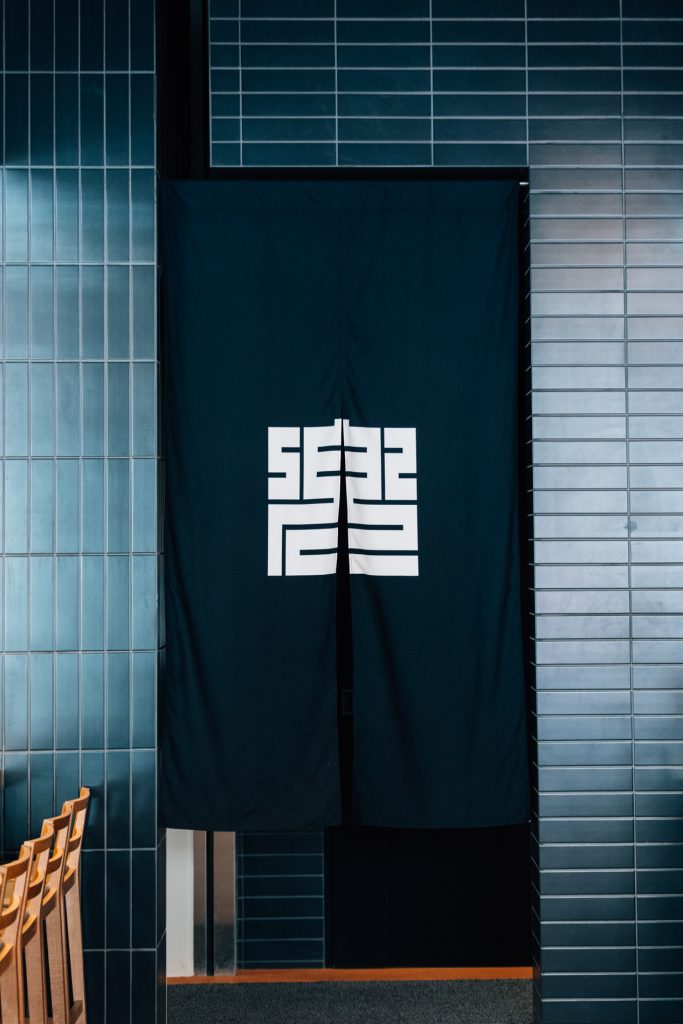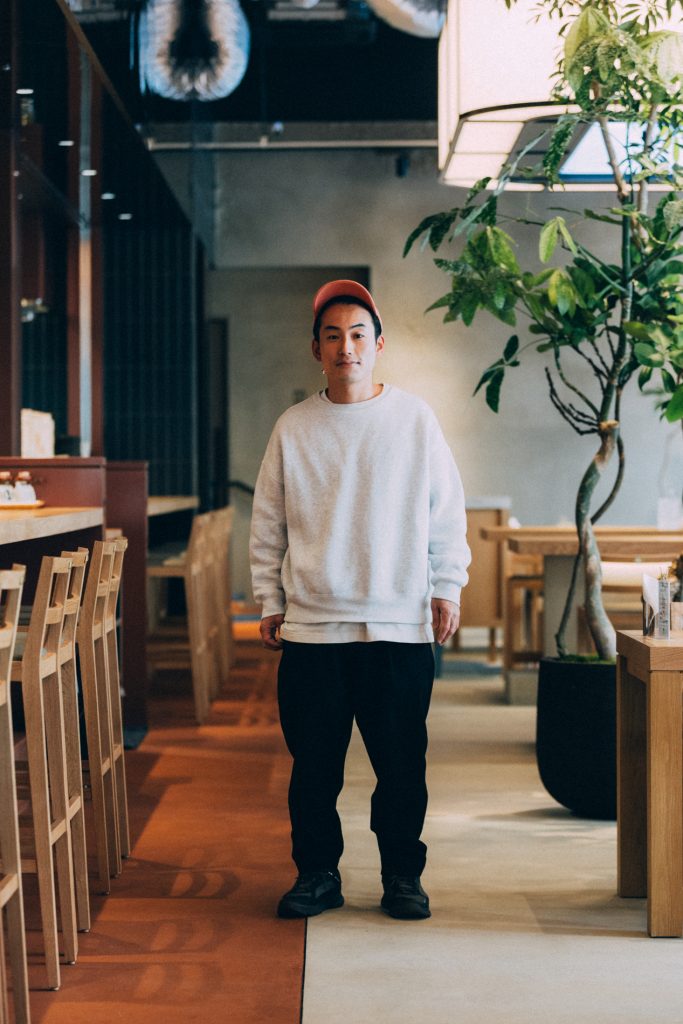


A place where chefs’ experiences can connect.
KABEAT is the infrastructure of Kabutocho
● Where are you from?
I was born in Osaka Prefecture and moved to Takarazuka City, Hyogo Prefecture when I was in elementary school.
●What was your childhood like?
I was an only child and both of my parents were working, so I had a lot of time to myself. I was given the keys to the house at a young age so quickly became used to doing housework and cooking food. I think I was lonely when I was little, so on my birthday, I would ask my parents for a sibling! My parents were a bit worried, so as a surprise they got me a dog, but I remember not being happy at all because I had a phobia of dogs due to an instance of being chased by a dog in the apartment we used to live in Osaka! The dog was a pug that had a skin disease, but it gradually became an important part of our family. Then I got a golden retriever. So, I always grew up with dogs.
●You seem to have a strong attachment to your dog.
That’s right. Actually, I was aiming to become a veterinarian, but in high school, I realized that it was too difficult for my brain! I had a strong background in science and mathematics, so I just went with the flow and entered a mechanical systems engineering course at university, even though I was not interested in it at all.
●Did you play any sports in school?
I used to do kendo when I was little, but I quit because I felt I could never surpass my father, who trained at an elite level at the time. When I was a student, I joined the track and field team and was a middle and long-distance runner. I chose that because I thought I couldn’t compete in short-distance running, but I guess I was always looking for something to be the best at. I am a persistent type of person, so middle and long-distance running suited me.
●How did you decide to become a chef?
I’ve always loved food since childhood. I’ve been cooking since I was a little and I was so happy to be able to make people happy through my cooking. I thought I didn’t want to go to university but I took the exam because my parents want me to go to university. But I failed the exam. When I told my parents that I wanted to go to a culinary school, they told me to go to a university because they had experienced hardships attending culinary school.
●Is that why you went to college?
I entered the engineering department of a university in Shiga Prefecture after studying for a year. But, I wasn’t really suited to engineering. I was living in Hikone, Shiga Prefecture, where it snows a lot. I got so into snowboarding that I took a leave of absence from university and eventually moved to Hakuba. I made the decision to move there all by myself, and told my parents after I had already moved!
●Didn’t you ever think of making a living from snowboarding?
I wanted to do it all because it was what I finally thought I wanted to do, but it was not an easy world. I moved to Hakuba when I was 21 years old, and I worked and lived there, trying to make a living by snowboarding. But I decided that after three years if I didn’t make any progress, I would quit. When I began thinking about what to do in life, I decided that the only thing I wanted to do was to become a chef. However, I was 25 years old at the time, so I felt it was too late to seriously pursue a career as a chef. I had never worked in the restaurant industry before, so I lacked confidence.
I wanted to directly convey the deliciousness and excitement of the produce.
●How did you find a job in the restaurant industry?
I was thinking that it would be difficult to enter a restaurant without knowing what I was doing, but my girlfriend at the time was a regular at a restaurant affiliated with Cafe Company (*1), and they were looking for part-time workers. I was offered a part-time job in the kitchen, but it didn’t feel right because the food in cafes is always very rigid. So I started working at RESPEKT, which is a street store of Cafe Company. It’s no longer there, but it was in Shibuya, and there was a club in the basement. That’s where I got my start as a chef.
※1 Cafe Company
The company was established in 2001. The main restaurant is called WIRED CAFE that plans and operates more than 100 restaurants, service areas, and hotels in Japan and abroad.
●What things did you learn as a chef?
The restaurant was based on Italian cuisine and all the cooks had come from various restaurants. Even though it was an open kitchen, it was like a battlefield, and I got a lot of training. I also realized that I like food that makes full use of the ingredients. I started out as a part-timer, but gradually I was recognized and finally was asked to become an employee. But when I talked to the chef, he recommended that I gain experience outside of the restaurant. I wanted to work at the best restaurant in town, so I ate my way around and started working at a restaurant called “Pizzeria Parlentesi” in Ikejiri-Ohashi. It was a busy restaurant, and since I was the lowest-ranking employee, I had to train from morning till late at night!
●In the past, I heard that training at a restaurant was very tough work.
I was working there for about a year when one of my former colleagues asked if I would help him to open a store in Ebisu. It’s called “Wanova,” and its parent company is a retailer of traditional Japanese crafts. The concept of the restaurant was to be a place where people could come into contact with the world. However, when I first entered the restaurant on my first day I found out that the chef had been replaced just before the opening! The staff also quit at an alarming rate! In the midst of all this, I felt the challenge and responsibility of producing my own output, so I just kept working on the task at hand. When I made the decision to become a chef, I always had a goal of becoming a head chef by the age of 30, even in a small restaurant, and I started to think that I might be able to achieve that here. When the chef quit, I became the head chef, and later, I also became the manager of the restaurant.
●Your perseverance paid off! What changes did you make to the restaurant?
There’s a traditional shop called ‘Edo-Tokyo vegetables’, it’s like a specialty store for vegetables. In Tokyo, there is surprisingly a lot of farmland, such as in the areas around West Tokyo and the nearby areas of Chitose Karasuyama and Sengawa. At KABEAT, we mainly use vegetables from producers in Chiba, but the freshness of vegetables is the most important thing. In fact, there are no vegetables that can’t be eaten raw, and as long as they are freshly picked, they can be eaten on the spot. However, the longer it takes, the more acetic acid gets into them and they become bitter. After being harvested, they are sent to agricultural cooperatives and markets, and from there they are sold to supermarkets before they finally reach us. But even if we buy them, we don’t cook them right away. It takes about a week from harvesting to eating them. That’s why I chose Edo-Tokyo vegetables because I wanted a restaurant that could serve them in the shortest time possible after being harvested. I wanted to directly convey the deliciousness and excitement of the produce. I wanted to create a restaurant that was like a Japanese bistro, with a genre-less menu where you can enjoy the true flavor of the vegetables, whether they are grilled or raw. I worked at Wanova for about five and a half years.
●It seems like a great place, why did you choose to leave Wanova?
I wanted to take on a new challenge. I had seen many of the senior chefs that I had worked with before, and I just knew that I didn’t want to aim for a position as a top chef. Chef Yonezawa and Chef Taira, who are supervising our menu this time, have been my friends since then, but I was aware that I couldn’t be like the other chefs assigned to KABEAT who are the talk of the town. However, when I decided that I wanted to work in the restaurant industry, I wanted to work hard on management and planning, so I began to seriously look for jobs in that field. That’s how I got a job at Smiles (*2).
※2 Smiles
President Masamichi Toyama plans and manages a variety of stores and events under the Smiles group: from restaurants to daily goods, such as Soup Stock Tokyo and the select thrift store, PASS THE BATON.
●What was it that attracted you to Smiles?
I wanted to have a lot of different job interviews so I could get to know all different types of companies. It gave me a chance to see what kind of questions they would ask and what kind of ideas they had. I decided that I wanted to join the most interesting company out of them all. Smiles was looking for a manager of a business team for a new brand, so it seemed like it was set in stone, but it wasn’t. In a good way and a bad way, it wasn’t clear what I was supposed to do. I thought it would be interesting to have the freedom to decide for myself and the room to create. I was involved with the launch of Pavilion, a store that was located under an elevated railway in Nakameguro.
●How did you go about setting up Pavilion?
I already had a concept in mind and was in talks with various creators, but hadn’t yet decided what the restaurant would be. So instead I started to think about the menu and cuisine. Because my role was to manage, I thought I wouldn’t have time to cook or come up with recipes, but when the restaurant opened, I had a chance to develop the menu and cook as a chef for tasting events. After opening the restaurant, I was involved in various planning, events, and sales promotions. After that, Smiles decided to start external consulting, and while working as the manager of Pavilion, I joined the project team as a member of the restaurant division.
●What kind of business consulting were you involved in?
I was involved in the launch of “Bunkitsu” in Roppongi. It is a stylish, entrance-fee bookstore offering a reading/ study space, cafe and tens of thousands of titles. When I joined the company, the concept for the restaurant had already been decided. I was in charge of food and beverage, working with the designers to match the concept of a pay-per-view bookstore with the structure and menu of a long-term stay bookstore. So I was in charge of food and beverage but would still discuss with the designer about concepts, ambiance, and other creative ideas. Smiles is a company that believes the most important thing: is to do the things that we believe in. I was really blessed with the members around me, and it was exciting and fun. But after three years, I wanted to begin a new challenge. That’s when I moved to my current company, GREENING (*3).
※3 GREENING
A hybrid company that combines the fields of cultural design, including architecture, food and beverage, hotels, art, and design, with the fields of digital technology, including IoT and AI.
I would like to have a chef that would challenge the old style of Italian and French cuisines, and bring originality to the genre.
●So that’s how you came to be in charge of KABEAT! Did you have any difficulties in starting up?
The KABEAT project started right after I joined the company, about two and a half years ago. It was a project that I had proposed before the pandemic started, so I had to change the concept slightly to something that was more in line with the current situation. I had many sessions and discussions with Heiwa Real Estate to make sure we were headed in the right direction. Initially, I was thinking of asking the head chef to develop a business model, but because of COVID, there were many risks involved. Also, from our point of view as operators, we couldn’t immediately change a store that wasn’t doing well. Rather, we tried to learn from the success of a fish restaurant that opened in Yokohama, where they had the chefs develop the menu, but also had the food producers at the core of the concept. That way, it would be easier for chefs to participate and let us better take on various challenges.
●What factors did you consider when choosing a chef?
Kabutocho is a new town. So I thought, if we are going to update the town, I would like to have a chef that would challenge the old style of Italian and French cuisines, and bring originality to the genre. I believe that a chef who is truly passionate about his or her work is an artisan, but that image has changed recently and in a good way. Chefs are now being recognized as creators. I’ve always wondered why creators and chefs were thought of as separate things. Cooking is something that doesn’t take shape and ends when you eat it. But that experience has to be created. In Japan, I feel that food and the people working in the industry are not recognized enough. I thought it would be great if KABEAT could be a platform for chefs who strive to be recognized as creators.
If everyone working at KABEAT can come out and brand themselves, I think that would be an achievement in itself.
●What kind of impression did you have of Kabutocho?
To be honest, I hadn’t been to Kabutocho very often myself, and I thought it was an austere town. Of course, I knew a lot of people involved with K5 and had heard a lot about it. But this place is much bigger for Kabutocho than I thought…… (laugh). It was quite a difficult project, but more than anything, the more I got to know the town, the more I felt the potential of its charm. At the same time, I knew what kind of impact KABEAT could have on my company and on the town, so I assigned more and more members of my company to the project.
●When KABEAT finally opened, did you find it challenging?
I was so relieved. I almost cried when I saw the six chefs lined up at the media preview. It’s great to see a project come to fruition, but I think management is the most important part. You can do as much planning as you like and start over easily. But when you get to the branding and operations side of things, like how to satisfy customers, you realize the true difficulty involved. I’m sure as the restaurant slowly starts to fill with customers, I will find it more and more rewarding. Also, I’m not the type of person to step forward and take the lead, so if everyone working at KABEAT can come out and brand themselves, I think that would be an achievement in itself.
●What do you envision for the future?
The first thing I want to do is stabilize KABEAT. Kabutocho is at the 1.5 stage of the update, and I think it will go through at least 5 cycles in the next 10 years! With 660 square meters of space, KABEAT offers a variety of cuisines and is open from morning to night. I think that KABEAT can become an infrastructure in Kabutocho, where people can casually drop in. I want to be the kind of person who says, “I’m glad Kabutocho has a space like that.” As for myself, I’ve always wanted to start my own business. I haven’t quite figured out what I want to do yet, but I would like to start a business that will attract more attention and recognition to people involved in the food industry.
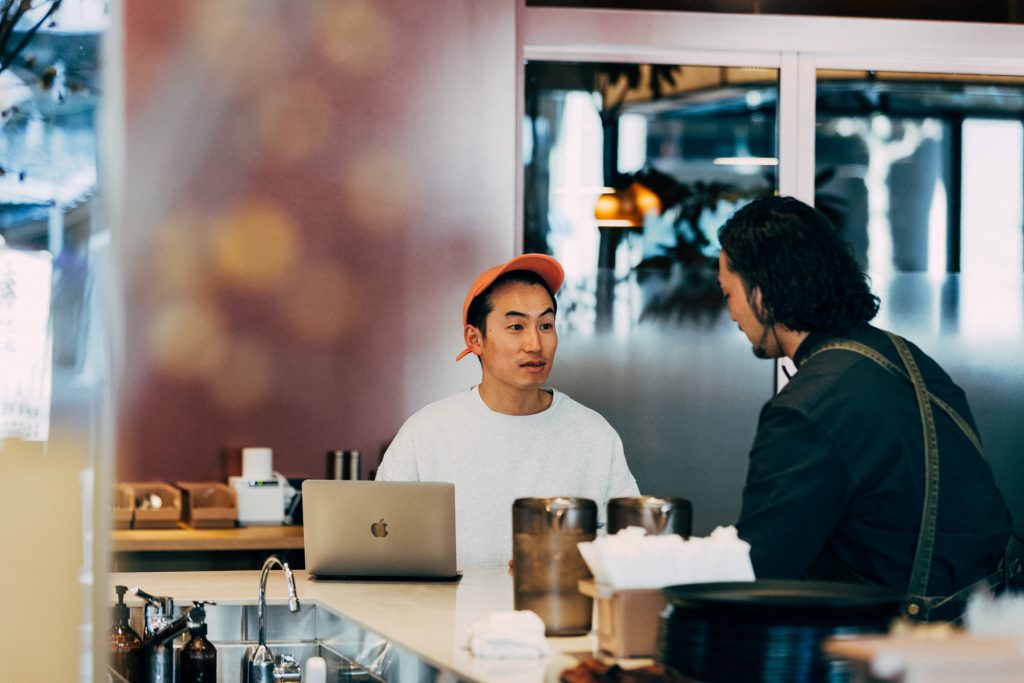
Hisaya Kuroki
Born in Osaka in 1949. He has been into snowboarding since he was a student and decided to become a chef at the age of 25. After gaining experience in restaurants, he became the head chef and manager of Wanova in Ebisu. After that, he shifted to the planning side of restaurant operations and was involved in the launch of Pavilion and Bunco through the company, Smiles. Currently, as manager of the GREENING planning and operations division, he has been in charge of “KABEAT” since its launch.
Text : Momoko Suzuki
Photo : Naoto Date
Interview : Momoko Suzuki
Hisaya Kuroki
Manager of the GREENING Planning and Operations Division
Mr. Ichiro Ito
HOPPERS
Interesting people in Kabutocho
Mr. Ichiro Ito from HOPPERS. I love Asian and Middle Eastern food, and I’ve always liked the restaurant Spice café. So I was very excited when the second store opened in Kabutocho. He even comes to KABEAT for lunch!
